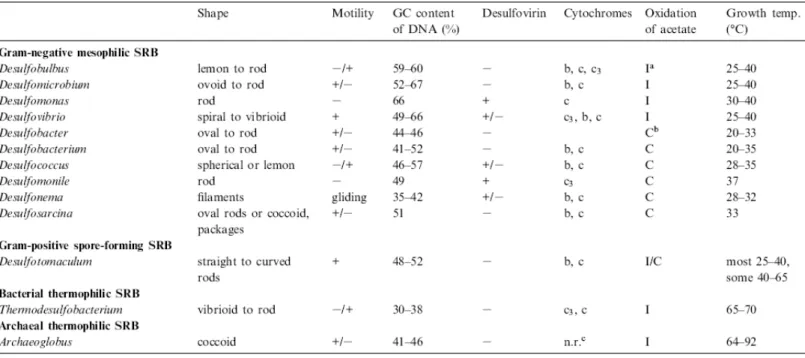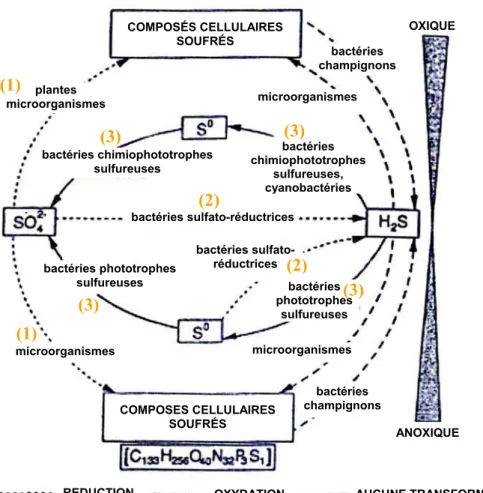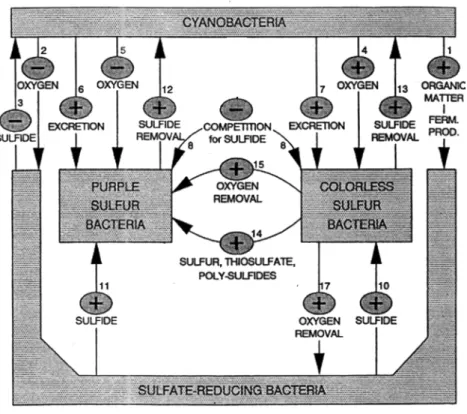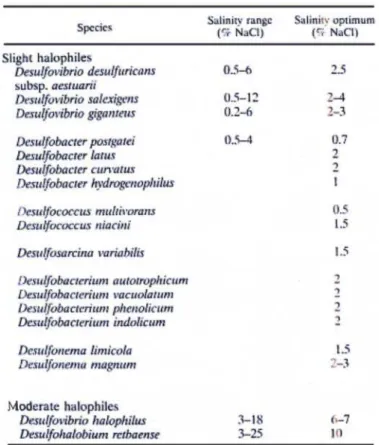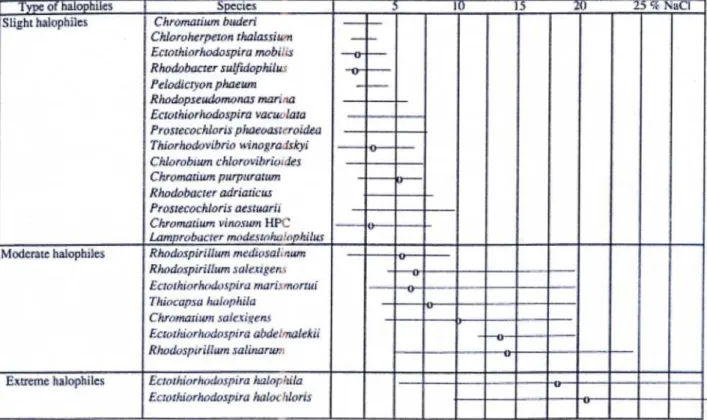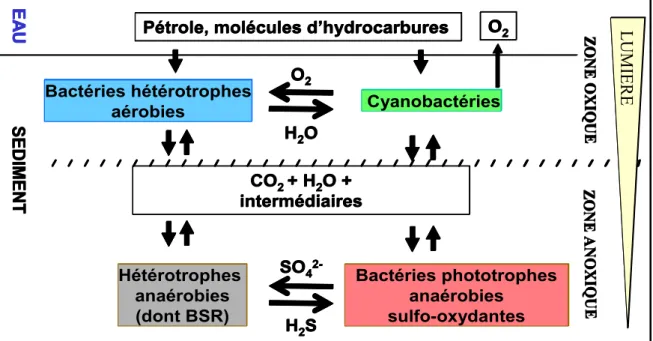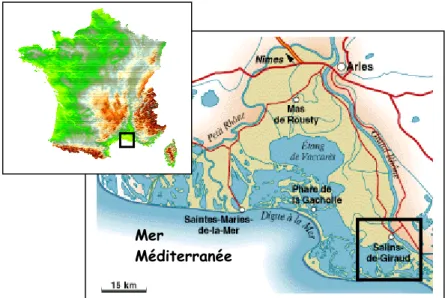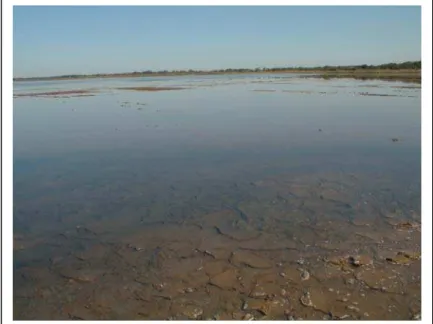L'objectif principal de ce travail de recherche était d'étudier la dynamique des communautés bactériennes dans les tapis microbiens afin de comprendre leur fonction et leurs mécanismes d'adaptation sous stress environnemental. Ainsi, la diversité bactérienne des principales communautés (eubactéries, bactéries phototrophes pourpres, bactéries sulfato-réductrices) de ces tapis microbiens a été décrite par une approche moléculaire T-RFLP. Le troisième point abordé a été l'analyse de l'impact des hydrocarbures sur les tapis microbiens de Guérande et de Camargue.
Les travaux présentés ici portent sur l'étude de la diversité des communautés bactériennes majeures des tapis microbiens en utilisant une approche de polymorphisme de restriction moléculaire T-RFLP (Terminal Restriction Fragment length Polymorphism). Face au stress salin, leurs adaptations en termes de diversité ont été abordées par l'étude de deux tapis microbiens différents, l'un hypersalin (Salins-de-Giraud, Camargue), l'autre marin (Orcades, Ecosse).
Etude bibliographique
Etude bibliographique
- Le tapis microbien
- Description générale
- Les groupes bactériens fonctionnels majeurs 1. Les cyanobactéries
- Structure verticale des communautés 1. Gradients physico-chimiques
- Adaptations aux stress environnementaux
- Salinité
- Gradients physico-chimiques
- Pollution d’hydrocarbures
- Les techniques moléculaires d’écologie microbienne
- La T-RFLP (Terminal Restriction Fragment Length Polymorphism)
- DGGE (Denaturing Gradient Gel Electrophoresis)
Parmi ces micro-organismes sulfoxydants, le genre Beggiatoa est particulièrement présent dans les tapis microbiens (Martinez et al., 1997). La réduction des sulfates est un processus important de minéralisation de la matière organique dans les environnements anoxiques, tels que les écosystèmes hypersalins et marins (Ollivier et al., 1994). Agrégation, observée dans le genre Desulfonema lorsqu'elle est trouvée à la surface du tapis (Sigalevich et al., 2000a).
Höpner et al., 1996) ont pu démontrer une adaptation significative des populations bactériennes après une pollution pétrolière. La technique DGGE permet la différenciation de fragments d'ADN de même taille (200-700 pb), mais de compositions en bases différentes (substitution de bases) (Muyzer et al., 1993).

Procédures expérimentales
Procédures expérimentales
- Sites d’étude
- Présentation
- Echantillonnages
- Carottage de tapis microbien (épaisseur 1 cm, diamètre 3 cm) à l’aide de seringues de 20 ml en plexiglas, enfoncées verticalement dans le tapis
- Collecte de sections de tapis microbien (50 x 50 cm, épaisseur 3 cm)
- Le tapis microbien de Camargue
- Le tapis microbien des Iles Orcades
- Le tapis microbien de Guérande
- Maintien de tapis microbien en microcosme
- Eau de mer synthétique (Camargue et Guérande)
- Mise en place d’un microcosme : exemple du tapis de Guérande
- Souches bactériennes, milieux de culture et conservation
- Souches bactériennes utilisées
- Milieux et conditions de cultures 1. Culture d’Escherichia coli
- Conservation des souches
- Techniques de biologie moléculaire 1. Extraction d’ADN génomique
- Réactions de polymérisation en chaîne (PCR)
- Purification des produits PCR
- Dosage de l’ADN par la méthode des « dots »
- Digestion enzymatique
- Electrophorèse
- T-RFLP
- RFLP
- Banque de gènes amplifiés 1. Principe
- Séquençage
Lorsque la salinité est d'environ 10 ‰ (m/v) (bassins de stockage), les principales populations microbiennes sont des cyanobactéries des genres Aphonothece, Microcoleus, Spirulina et Oscillatoria, mais aussi Chromatiacae. Ils ont ensuite été stabilisés dans de l'eau de mer synthétique 70‰ (m/v) (voir II.1.3 Entretien des tapis microbiens dans les microcosmes) sous lumière naturelle. A partir des parcelles de tapis collectés, quatorze carottes de tapis microbiens (5 cm de diamètre et 1 cm d'épaisseur) ont été stockées en microcosme dans des carottes de verre, dans de l'eau de mer synthétique à 70 ‰ (m/v).
Après avoir effectué une série de dilutions en déposant, parallèlement aux échantillons à analyser, de l'ADNg de sperme de saumon à différentes concentrations connues (5 ng.µl-1 à 1 µg.µl-1), les gels sont visualisés sous lumière UV. Calcul de l'indice de similarité (Sij) entre tous les échantillons (en fonction de leurs profils T-RFLP).
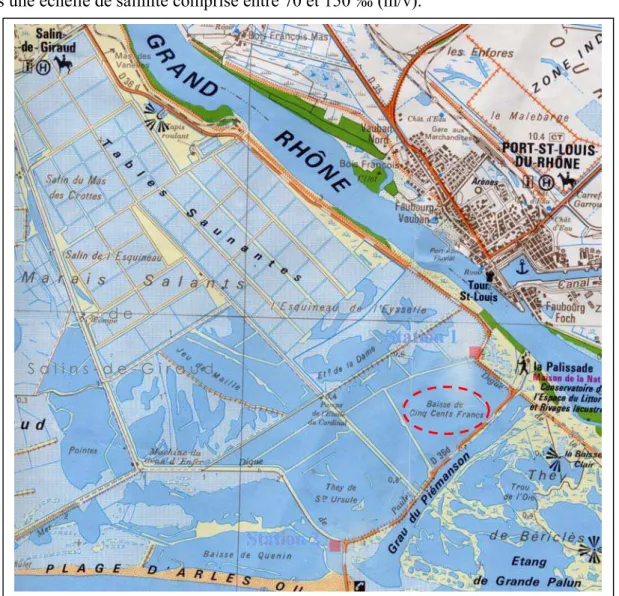
Description de tapis microbiens
Description de tapis microbiens
- Introduction
- Le tapis microbien hypersalé de Camargue (Salins-de-Giraud)
- Le tapis microbien marin des Iles Orcades (Ecosse)
Spectral scalar irradiance measurements did not reveal a particular zoning of cyanobacteria, purple or green bacteria in the first millimeter of the mat. Microbial mats existing in the most hypersaline ponds of the Salins-de-Giraud (Camargue, French Mediterranean coast) salt marshes were described in ecological, microbiological and recently molecular studies for more than ten years [6,9–11]. Bacterial diversity in the upper active layers of the microbial mat Bacterial diversity estimated by biomarkers.
24-methylcholesta-5,24(28)-dien-3β-ol [36-38] was found in small proportion, suggesting the presence of diatoms possibly in the surface layer of the mat. In addition, the distribution of bacterial communities involved in the carpet sulfur cycle was also investigated. Similarly, the CFA of this data set showed a specific distribution of SRB.
Measurements of spectral scalar radiation showed the presence of purple bacteria in the surface layer of the mulch, especially in the zone at a depth of 0.5-0.8 mm (Figure 2). As revealed by spectral scalar irradiance (Figure 2), CLSM (Table 2) and DGGE (Figure 5), cyanobacteria were the dominant rather diverse photosynthetic microorganisms, very active in the first millimeter of the mat. Their presence was also shown by the absorption of BChl c detected in the upper layer of the carpet (Figure 2).
Sulfate-reducing bacteria are also present in large numbers in the upper millimeters of mats [88, 98]. The pH readings of the microelectrode in the water above it were adjusted to the measured pH of the seawater. The strong absorption of Chl a and BChl a indicates the presence of dense populations of oxygenic and anoxygenic phototrophs in the upper 2.6 mm of the mat.
The biodiversity of the sulfate-reducing bacteria (SRB) was analyzed using the primers 8f-SRB385 and the combination of both restriction enzymes (HaeIII, Hin6I). Glycine betaine, one of the most abundant compatible solutes [94], and the osmoregulatory compound of marine algae, DMSP [42], present in high concentrations in microbial mats [39, 89], are precursors of trimethylamine and DMS [65] .
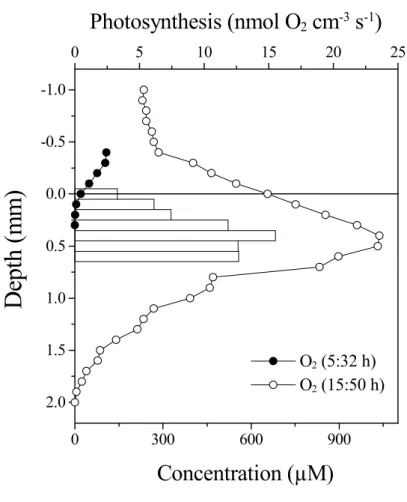
Dynamique verticale des populations bactériennes en fonction des fluctuations physico-
Dynamique verticale des populations en fonction des fluctuations physico-chimiques d’un cycle nycthéméral
- Bactéries photosynthétiques
Among cyanobacteria, the gliding bacterium Microcoleus chthonoplastes has been described as dominant in hypersaline environments (García-Pichel et al., 1994; Fourçans et al., 2004), marine intertidal microbial mats (Stal and Krumbein, 1985; Stal and Krumbein, 1985) in hot deserts. (Campbell, 1979). This study used the main features of this microscope that facilitate observation of cyanobacteria in microbial mats (Solé et al., 2001a). Cyanobacteria identification in the Salins-de-Giraud microbial mats by CLSM was described in a general sense in (Fourçans et al., 2004).
Values for length, width and biovolume were calculated according to the expressions described in (Solé et al., 2001a). The Salins-de-Giraud microbial mat presented a limited diversity of cyanobacteria compared to other mats studied, possibly due to the fact that salinity favors lower diversity (Fourçans et al., 2004). Halomicronema excentricum develops in hypersaline environments, as it was described in the microbial mats of Solar Lake (Eilat, Israel) (Abed et al., 2002).
Indeed, (Moezelaar et al., 1996) demonstrated their ability to ferment carbohydrates in the dark by using sulfur as an electron acceptor and producing sulfide. -RFLP fingerprinting of PAB communities, based on the analysis of their own pufM gene, allowed a spatial assessment of their biodiversity within the carpet at the micro-level (Fourçans et al., 2004). A canonical correspondence analysis (CCA) was performed, incorporating biogeochemical data (O2, pH, H2S, Stot, measured parallel to sampling) from (Wieland et al., 2003), M. chthonoplastes iomass and T-RFLP data on PAB. in order to estimate clock parameters 6).
Active photosynthesis of cyanobacteria on the matte surface during the day promotes a rise in pH up to 9.4 along the first 1.5 mm (Wieland et al., 2003). -Pichel et al., 1994) have already described the behavior of some cyanobacteria that slide to optimal conditions in a hypersaline microbial mat, mainly in response to light. Oxygen is toxic to obligate anoxyphototrophic bacteria; therefore, these bacteria react with a negative chemotactic response (Armitage et al., 1979).
Abundance Relative (%)
Relative depth abundance of different cyanobacteria characterized by CLSM during the diel cycle in the Camargue carpet.
Biomass (µgC/cm 2 sediment)
Histograms of the relative abundance of the 5' end of the amplified HaeIII-digested pufM fragments for each layer measured at 15:00, obtained from T-RFLP profiles.
Percent
Bactéries sulfato-réductrices
-RFLP analysis of the 16S rDNA gene revealed the important dynamics of all eubacteria developing within four millimeters of the microbial mat. An OTU (157 bp) associated with a new Desulfobacter species remained immobile independent of diel microgradients. The entire 16S rDNA gene sequences were determined from these plasmids by primer walking (Biofidal, France).
Indeed, the OTU of 157 p (HaeIII digest) was localized along the 4 mm of the mat both night and day. A second primer set targeting only species of the genus Desulfobacter (Daly et al., 2000) was used to examine their spatio-temporal distribution in the mat over a diel cycle. HaeIII digestion) was observed precisely in 0-. This OTU, which is related to all species of the genus Desulfobacter described so far, showed a high tolerance to oxygen when located at the surface of the mat at 15:00 with oxygen concentration up to 907 µM (Wieland et al., 2003a).
Phylogenetic analysis of 16S rDNA sequences revealed that this SRB community could correspond to new species of the Desulfobacteriaceae family. Therefore, this study demonstrated the dynamic behavior of the sulfate-reducing bacteria within the few metabolically active millimeters of the Camargue microbial mat. The right outline corresponds to schematic oxygen profiles along the four millimeters of the mat, obtained from Wieland et al.
Comparison of fingerprints of sulfate-reducing bacterial communities between 4 a.m. and 3 p.m. for each studied layer within four millimeters of the Camargue mat. Electropherograms of the T-RFLP profiles at the 5' end were obtained from HaeIII-digested 16S rDNA amplified with primers DSB127F - DSB1273R. Sulfate reduction and possible aerobic metabolism of the sulfate-reducing bacterium Desulfovibrio oxyclinae in a chemostat.

Adaptation des populations bactériennes face à une pollution
Adaptation des populations bactériennes face à une pollution d’hydrocarbures
- Tapis microbien de Guérande soumis à une pollution par le pétrole de l’Erika
Depuis plusieurs décennies, le développement de l’industrie conduit à l’utilisation massive du pétrole comme source d’énergie ou matière première pour la fabrication de divers produits chimiques. Les conséquences écologiques et économiques des nombreux accidents pétroliers (Amoco Cadiz, Erika, Prestige, pollution pétrolière du golfe arabo-persique après la guerre du Koweït, etc.), ont conduit à des recherches vers l'étude intensive des bioprocédés - réhabilitation. Les tapis microbiens sont considérés comme des écosystèmes compacts parfaitement organisés où l'activité métabolique de chaque composant bactérien dépend de l'activité des autres membres de la communauté (van Gemerden, 1993).
Ainsi, puisque la production et la consommation de matière organique ne sont séparées que de quelques microns à quelques millimètres, les tapis microbiens offrent un énorme potentiel métabolique qui peut être exploité pour les processus de bioremédiation. En effet, pendant la guerre du Golfe, il a été démontré que les tapis microbiens pouvaient jouer un rôle important dans la biodégradation du pétrole provenant des zones côtières contaminées (Höpner et al., 1996). M. Les connaissances actuelles sur la biodégradation des hydrocarbures proviennent principalement de l'étude des souches d'oclastes d'hydrocarbures en cultures pures (Rabus et.
Cependant, des études récentes sur les tapis microbiens contaminés, axées sur la dynamique des communautés, la diversité bactérienne et leur potentiel de dégradation, contribuent à une meilleure compréhension des processus. Ce chapitre se concentre sur l'étude de l'impact des hydrocarbures sur les populations bactériennes issues des tapis microbiens, ainsi que sur leur capacité d'adaptation et donc de dégradation de ces hydrocarbures. La première partie de ce chapitre, détaillée dans l'article intitulé « Dégradation du fioul Erika », traite de l'étude de l'impact du pétrole brut Erika sur les microorganismes du tapis microbien des marais salants de Guérande (Bretagne). , et leur potentiel. pour dégradation.
Les tapis de Guérande conservés en microcosmes en laboratoire et contaminés par l'huile de l'Erika pendant 3 mois ont été analysés par T-RFLP. Parallèlement, le potentiel métabolique de dégradation des hydrocarbures des différentes communautés de ces tapis a été compris en étudiant la diversité des gènes codant pour les dioxygénases. Ces enzymes impliquées dans la dégradation des hydrocarbures montrent une grande diversité dans cette étude, suggérant que les tapis microbiens ont un potentiel de dégradation important.
